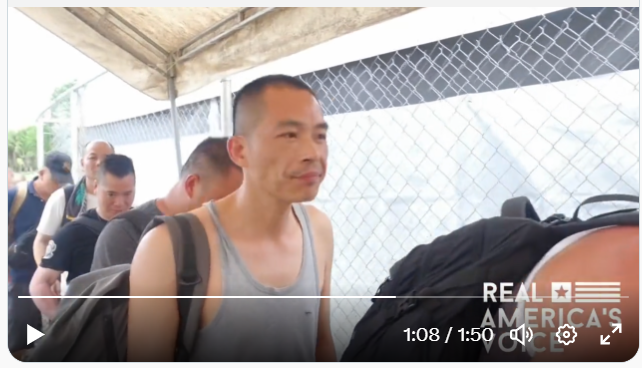Oscar El Blue Ramirez of Real America’s Voice posted footage of his interviews with a large group of migrants from China, who were identifying themselves and saying they were headed to the United States from a migrant camp in Panama.
WATCH:
Thousands of Chinese migrants and asylum seekers have arrived at the U.S.-Mexico border in recent months, and many more are heading north after passing through the treacherous Darién Gap jungle between Colombia and Panama, Axios reported in March, adding that the migration from China is another example of people from well beyond the Americas seeking refuge in the U.S. through the southwest border — and reflects the ongoing backlash to Chinese President Xi Jinping’s harsh domestic policies.
The outlet went on:
During the first two months of this year, nearly 2,200 Chinese nationals have crossed into Panama through the thick jungle of the Darién Gap, according to migration data from Panama’s government.
- That’s more than the 2,000 Chinese migrants who made the trip in all of 2022 — which itself was a huge jump from the 77 counted in 2021.
- “This exodus signifies Chinese people’s resistance to President Xi’s regressive policies and draconian lockdown measures,” Sam told Axios. “It’s like an animal stampede before an earthquake.”
The big picture: There has long been Chinese migration at the southern border, going back to the 1980s.
- But the numbers have ticked up in recent months because of a variety of factors, such as the reopening of China’s borders and growing backlogs for legal immigration pathways to the U.S.
- Chinese nationals also are granted asylum at a relatively high rate in the U.S. — 58%, according to recent government data. That’s compared to an average of 10% for asylum seekers from the Northern Triangle, which includes Guatemala, Honduras and El Salvador.
- Bob Fu, president of the Christian nonprofit ChinaAid, which advocates for human rights in China, has noticed the uptick in Chinese migrants at the southern border. He said his group now receives several assistance requests from these migrants every week.
- He gave three reasons for this uptick: Further deterioration in human rights conditions and religious freedom in China; a rollback of more stringent U.S. border policies that were in place under President Trump, and social media posts about people crossing, which have triggered a bandwagon effect.
Reports from Yuma Arizona are that the numbers of migrants from China, reaching that area are up:
Tom Squitieri, a journalst from Hungry reported on more details of the migration from China:
CHINESE MIGRANTS: According to U.S. Customs and Border Protection, 4,366 migrants from China encountered Border Patrol officials after crossing the southern border without authorization from October 2022 to February 2023. That compares with the 421 migrants who were encountered during the same period in 2021 and 2022.
One video showed hundreds of Chinese migrants at a camp near the Panama-Colombia border. It showed what the narrator called “a line of “military-age males” who were lining up to board buses to continue their journey to the U.S.-Mexico border. Military leaders have told Congress in the past that the Western Hemisphere is the front line of competition with China, describing Beijing’s efforts as a “full-court press.” Some have said they feel a sense of urgency as they see U.S. influence is eroding.
Recent Chinese actions, like financing a $3 billion container port, establishing a space monitoring station near the Straits of Magellan and buying lithium mining operations in three South American nations, pose increasing risks to U.S. security, senior military commanders said.
The Chinese activities are a “relentless march” to replace the United States as a leader in the region, Army Gen. Laura Richardson, the top officer at Southern Command, testified before the House Armed Services Committee earlier this year. As an example of that threat, she warned the Chinese Space Agency station in Argentina used to explore the dark side of the moon and track satellites could also be used for targeting.
Atop this list of must-dos are to keep the Panama Canal, the Straits of Magellan and Drake Passage open to maritime trade, she said. Richardson voiced concern over the dual-use capabilities of these state-owned enterprises and Chinese companies expanding their reach in the hemisphere.
